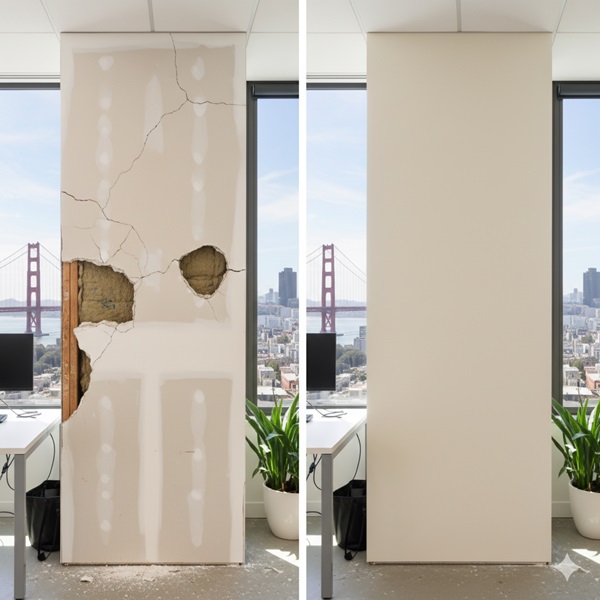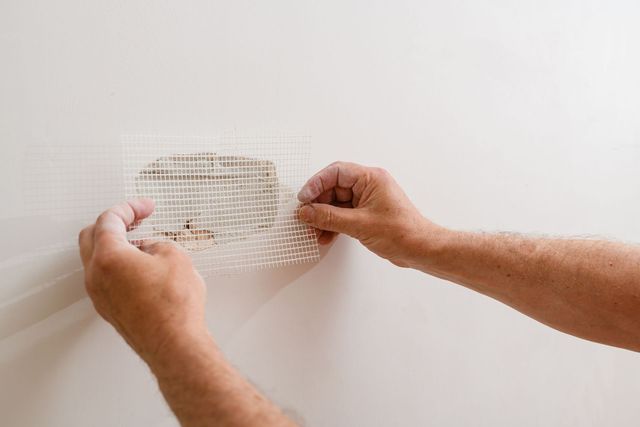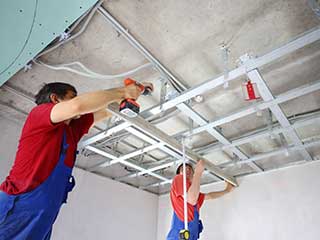A Comprehensive Guide to Learning Drywall Repair Service and Installment
This overview supplies a comprehensive expedition of drywall repair work and installment, dealing with both amateurs and skilled professionals. It outlines important tools, strategies for patching and hanging sheets, and the vital finishing procedures. drywall contractors. By understanding common risks, individuals can achieve sleek outcomes. Understanding these skills not just improves one's home but also builds confidence in DIY undertakings. What fundamental pointers will assure an effective job from beginning to end?
Vital Devices for Drywall Repair and Installation
When beginning on drywall repair work and setup, a couple of important devices can significantly boost the effectiveness and high quality of the work. A drywall blade, generally available in different sizes, is important for applying joint compound and smoothing seams. A taping knife is likewise needed for feathering sides and making sure a seamless surface. In addition, a drywall saw or energy knife permits for precise cutting of drywall sheets to fit any kind of room.

Step-by-Step Overview to Patching Holes
Covering openings in drywall is a straightforward process that can restore the wall's look and stability. To start, the area around the hole must be cleaned up and any kind of loosened particles got rid of. For tiny holes, a simple spackle or joint compound can be applied with a putty knife. Bigger openings may require a spot; a piece of drywall can be reduced to fit the opening, protected with sticky or screws, and after that taped around the sides. When the patch is in place, joint substance is used over the spot and feathery out to blend with the bordering wall surface. After the substance dries out, sanding is necessary to attain a smooth coating. The fixed location can be topped and painted to match the rest of the wall. This technique ensures a seamless repair, boosting the total look of the drywall and keeping its architectural integrity.
Strategies for Hanging Drywall Sheets
After efficiently fixing openings in drywall, the following step involves hanging new drywall sheets to develop a seamless surface area. To attain this, one must start by determining the wall area properly and cutting the drywall sheets to fit. It is important to hang the sheets flat for better structural honesty, beginning with the top and functioning downwards.
Making use of a drywall lift can simplify the process, specifically for ceiling setups. When placed, securing the sheets with drywall screws at intervals of concerning 12 inches along the edges and 16 inches in the field is essential. This ensures a firm hold and reduces the threat of sagging. For corners, the sheets should be cut to fit comfortably, permitting for cleaner seams. Finally, it is suggested to stagger the joints between sheets to strengthen the overall framework, producing a much more long lasting coating ready for the next phase in the drywall installment process.
Finishing Touches: Insulation and Mudding
Completing the drywall installation includes the important actions of taping and mudding, which ensure a sleek and smooth coating. Taping calls for the application drywall contractors of joint tape over the seams between drywall sheets. Drywall Repair Ogden UT. This tape can be either paper or fiberglass harmonize, with each type offering distinct benefits. After taping, the next step is mudding, where joint compound, or "mud," is applied to cover the tape and fill any imperfections
Making use of a drywall knife, the substance ought to be spread uniformly, ensuring a feathered side to minimize noticeable modifications. Multiple layers are commonly essential, with sanding in between each layer to achieve a seamless surface area. Cautious focus throughout this process is essential, as it significantly affects the last look of the wall surface. With the ideal strategy and perseverance, completion result will certainly be a remarkable structure prepared for painting or ending up touches.
Common Errors to Avoid in Drywall Projects

An additional common mistake is not allowing enough drying out time between layers, which can catch wetness and jeopardize the finish. Ignoring to feather the edges effectively can produce visible lines and blemishes. Ultimately, avoiding sanding or using incorrect strategies may leave harsh spots. By understanding these pitfalls, people can substantially enhance the high quality of their drywall jobs and accomplish a professional-looking coating.
Regularly Asked Inquiries
Can I Repair Drywall Without Expert Aid?
Yes, one can repair drywall without professional assistance. With the right devices, materials, and support, individuals can efficiently manage minor fixings. However, considerable damage might need professional knowledge for excellent outcomes and longevity.
For How Long Does Drywall Compound Require To Dry?
Drywall substance normally takes between 24 to 48 hours to completely dry completely, depending upon factors such as humidity and temperature level. Thinner layers may dry faster, while thicker applications call for even more time for perfect results.
What's the very best Kind Of Paint for Drywall?
The very best kind of paint for click for source drywall is typically a water-based latex paint. It offers outstanding protection, toughness, and convenience of application, making it ideal for indoor wall surfaces while permitting very easy cleaning with soap and water.

How Do I Prevent Mold on Drywall?
To stop mold on drywall, assurance proper ventilation, control humidity levels, make use of mold-resistant products, and promptly address any leaks. Routine inspections and instant remediation of water damage are likewise crucial for long-lasting prevention.
Is Drywall Recyclable After Removal?
Drywall is recyclable after elimination, offered it is without pollutants like mold, paint, or various other hazardous materials. Recycling centers can refine it right into new products, advertising sustainability and decreasing garbage dump waste in construction.
When starting on drywall fixing and setup, a couple of vital tools can considerably enhance the performance and high quality of the work. After efficiently fixing holes in drywall, the next step includes hanging new drywall sheets to develop a seamless surface. Finishing the drywall installment entails the crucial steps of taping and mudding, which guarantee a smooth and polished finish. Achieving a refined coating in drywall jobs can be tough, and several common mistakes can undermine the high quality of the job. Yes, one can fix drywall without specialist aid.